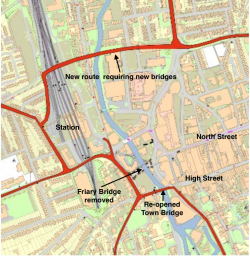 Abraham Lincoln
If given the truth, the people can be depended upon to meet any national crisis...
Abraham Lincoln
If given the truth, the people can be depended upon to meet any national crisis...
 Guildford news...
for Guildford people, brought to you by Guildford reporters - Guildford's own news service
Guildford news...
for Guildford people, brought to you by Guildford reporters - Guildford's own news service
Letter: Why Would A New Railway Bridge Help?
Published on: 4 Aug, 2016
Updated on: 6 Aug, 2016
From David Smith
Can someone explain why a link over the railway joining to York Road would help so much?
Surely traffic coming down Guildford Park Avenue and Farnham Road will be trying to get down to the A281? It’s the right hand lane of Bridge street that is solid, not the other two going in the Woodbridge Road direction – so why would somebody want to get onto Woodbridge Road from A31 and Park Avenue?
If the answer is to travel in the Ladymead direction they could have done that by joining the A3 at Onslow? It seems to me, traffic is coming along the Woodbridge Road to get to the A281 and Portsmouth Roads and traffic from Park Avenue and Farnham Road is the same.
Building a bridge will therefore solve nothing other than halting much needed development with a concept that even Highways at SCC don’t see as being credible.
Whilst we are having trials of possible improvements (like the Walnut Tree Close closure) could we not look at making two lanes on Bridge Street go right and one go left. At the crossing the left lane could open up again to two lanes outside Harpers?
Too many times cars at Walnut Tree Close get stuck because they cannot pull out onto this third lane and cars in this third lane pile back blocking cars off Farnham Road Bridge joining the gyratory because there is no movement during traffic-light changes.
Responses to Letter: Why Would A New Railway Bridge Help?
Leave a Comment Cancel reply
Please see our comments policy. All comments are moderated and may take time to appear. Full names, or at least initial and surname, must be given.
Click on cartoon for Dragon story: Public Asked for Views on SCC’s Proposal for Reduced Speed Limits






Recent Articles
- A Hidden Gem in the Hills: Michelin-Backed William IV Pub Brings Refined Dining to Albury
- Letter: Help Reduce Speeding By Joining a Community Speedwatch Team
- Hospital Apologises ‘Unreservedly’ After Death Of Disabled Girl
- Birdwatcher’s Diary No.328
- SCC Intends to Back Public Survey Result and Shorten Summer School Holidays
- A281 Expected to Remain Closed Until Repairs to Damaged Cottage Are Completed
- Surrey Heath Selling Assets to Maintain Essential Services
- Community Councils Proposed to Maintain Local Representation
- Highways Bulletin – A320 Weekend Closures
- Updated: Can You Help Find Missing Nigel?


Recent Comments
- Jim Allen on Community Councils Proposed to Maintain Local Representation
- Jeremy Holt on Community Councils Proposed to Maintain Local Representation
- Lisa Land on Birdwatcher’s Diary No.328
- Jules Cranwell on Community Councils Proposed to Maintain Local Representation
- Sara Tokunaga on Public Asked for Views on SCC’s Proposal for Reduced Speed Limits
- David Roberts on Community Councils Proposed to Maintain Local Representation
Search in Site
Media Gallery
Dragon Interview: Local Artist Leaves Her Mark At One of England’s Most Historic Buildings
January 21, 2023 / No Comment / Read MoreDragon Interview: Lib Dem Planning Chair: ‘Current Policy Doesn’t Work for Local People’
January 19, 2023 / No Comment / Read MoreA3 Tunnel in Guildford ‘Necessary’ for New Homes, Says Guildford’s MP
January 10, 2023 / No Comment / Read More‘Madness’ for London Road Scheme to Go Ahead Against ‘Huge Opposition’, Says SCC Leader
January 6, 2023 / No Comment / Read MoreCouncillor’s Son Starts Campaign for More Consultation on North Street Plan
December 30, 2022 / No Comment / Read MoreCounty Council Climbs Down Over London Road Works – Further ‘Engagement’ Period Announced
December 14, 2022 / No Comment / Read MoreDragon Interview: GBC Reaction to the Government’s Expected Decision to Relax Housing Targets
December 7, 2022 / No Comment / Read MoreHow Can Our Town Centre Businesses Recover? Watch the Shop Front Debate
May 18, 2020 / No Comment / Read More







Caroline Reeves
August 4, 2016 at 6:13 pm
I think you might find that is what is planned for Bridge Street – as David Smith says, it’s the obvious thing to do.
Bibhas Neogi
August 6, 2016 at 8:56 am
Really? Wouldn’t this create longer queues around the gyratory for all the traffic heading for northbound Onslow Street?
Why doesn’t the council revisit its disastrous decision to close Debenhams subway, one of the main reasons for the tailbacks on to the gyratory? Tailbacks also block the right hand lane on Bridge Street and even Onslow Street sometimes, from about the York Road roundabout.
The subway, the ramps and the steps have been filled in with concrete, so reopening the subway is not possible but measures could be taken to improve flows.
I believe the solution would be to make this crossing a two-stage one by creating an island in the middle and operating the High Street crossing in tandem with this crossing so that traffic queuing to turn left on to High Street does not block the southbound flow.
By reducing the time pedestrians take to cross a single lane as opposed to three lanes in one go, gives the southbound traffic more time in each cycle of traffic light phasing. Pedestrians take a little longer to cross but the slight delay should be acceptable since this arrangement also increases safety by reducing their interaction with traffic.
Jim Allen
August 4, 2016 at 11:07 pm
One could always simply remove all controls bus lane and lights throughout the town and let the traffic run freely on the current road layout. Six months should prove the point.
Martin Elliott
August 6, 2016 at 11:25 am
Surely the issue is the aim stated in the Local Plan regarding traffic: that is to join up pedestrian areas and make traffic come to Guildford, not through it.
That means removing one of the fundamental reasons for Guildford’s development; it has historically been a gap town.
As demonstrated by the repeated proposals of the new railway bridge, there are still no proposals for where north-south or east-west local traffic is meant to go.
Other towns near Guildford like Kingston have combined redevelopment with new road development to generate routes around the town centre.
All we have in the Local Plan are traffic proposals which couldn’t cope with, or provide alternative routes for, current traffic.
Harry Eve
August 11, 2016 at 6:27 pm
There is some data on traffic flows on the council website as part of the Masterplan evidence. Although there need to be caveats around the value of a single day survey (I think that was the case) and the effects of queuing (changes in queue lengths over the time period measured) the results are worth looking at as a starting point for further investigation.
Town Centre Masterplan : Guildford Borough Council
Takes you to three links on the gyratory.
The Summary Note has data on page 3. Here is the direct link:
http://www.guildford.gov.uk/media/20021/Summary-Note—Transport-proposals-AM-Arup-September-2015/pdf/Summary_Note_-_Transport_proposals_(AM__Arup_Sept_2015).pdf
I think the GOTCHA team are carrying out micro-simulation work now.
Bibhas Neogi
August 13, 2016 at 8:38 am
On page 2 of design/engineering company Arup’sSept 2015 report, it says:
“The following table illustrates why a tunnel option would not solve the problems with the gyratory. Currently, there is no dominant individual movement through the gyratory, with traffic flows fairly even spread between Shalford Road, Portsmouth Road and Farnham Road. This means that major infrastructure solutions that address one movement through the gyratory have a limited benefit and would not justify major infrastructure.”
I think Arup has missed evaluating or has not been asked by the council to include an option that has both the short tunnel and a two-lane bridge (not four-lane route as suggested by GVG) carrying traffic to and from Farnham Road to Woodbridge Road.
The option of a two-lane East West link together with making Farnham Road Bridge one-way into the town centre and converting the rest of the gyratory into two-way, opening up Town Bridge, a short tunnel for the A281 and a high level walkway from the station to the Friary/Onslow Street, provides a viable alternative.
This option achieves a pedestrian friendly town centre, allows removal of Friary Bridge to open up vista for the riverside amenity area, costs less than GVG option and it is much less disruptive. Above all it would achieve improvements to traffic flows, safer and wider pedestrian routes and cycle routes from all connecting roads which other options may not provide.
Bibhas Neogi
September 30, 2016 at 10:14 am
Well, no comments for or against my proposals so far has been posted. I can only assume that this idea got the readers and hopefully the councils thinking (deeply) about the alternative scenario that I have suggested.
Any mention of a tunnel conjures up the fear of high cost of tunnels especially after Hindhead Tunnel that cost some £370 million.
However, not all tunnels or tunnel-like structures are expensive infrastructures. The example I have included on my website is really a very wide underbridge that could be built, yet capable of maintaining one lane of traffic during its construction, and its costs would be comparable to building bridges rather than tunnels.
I would hope councils would ask their consultants again to evaluate this scenario and then make their recommendations for the town centre modifications.